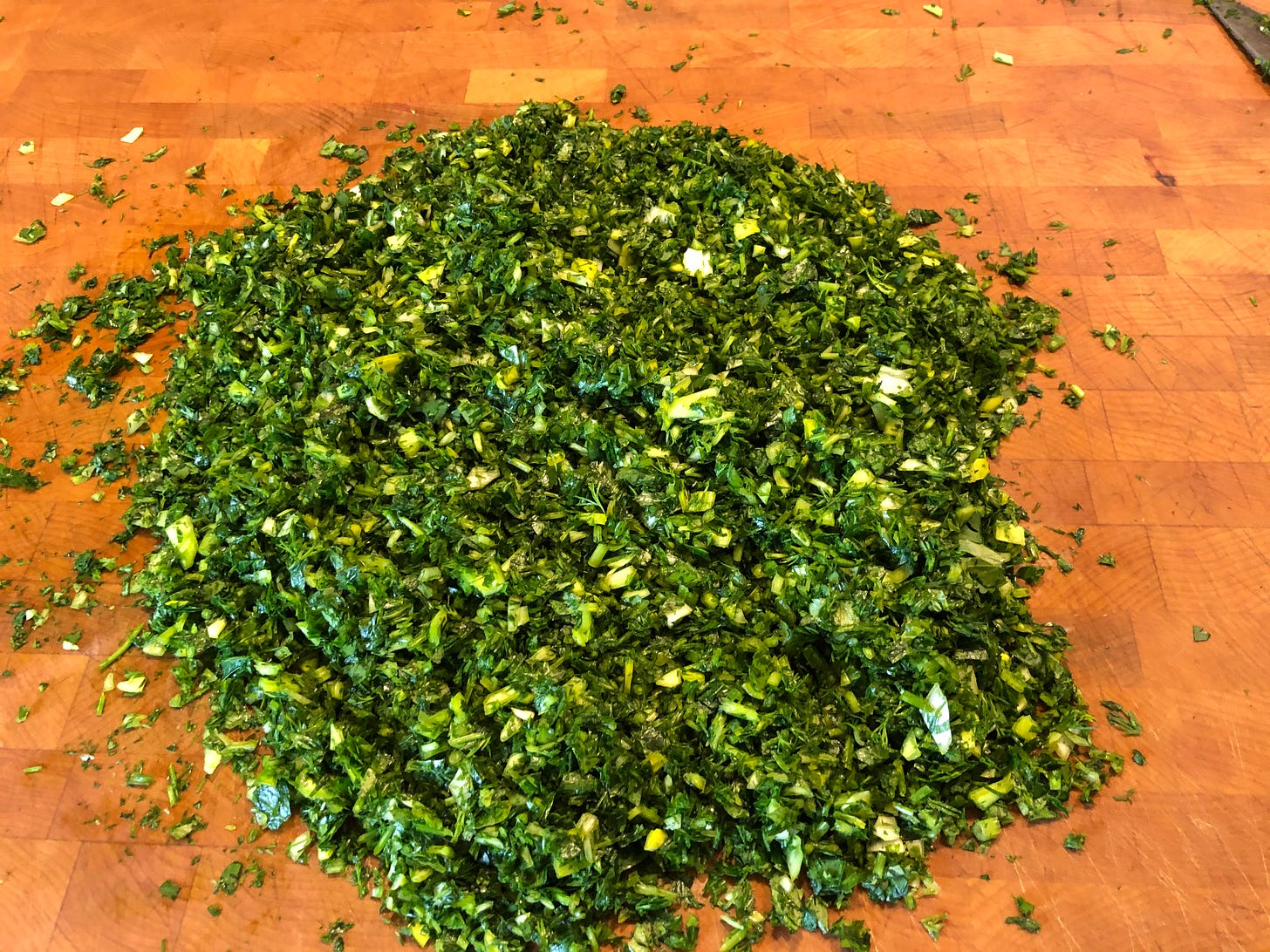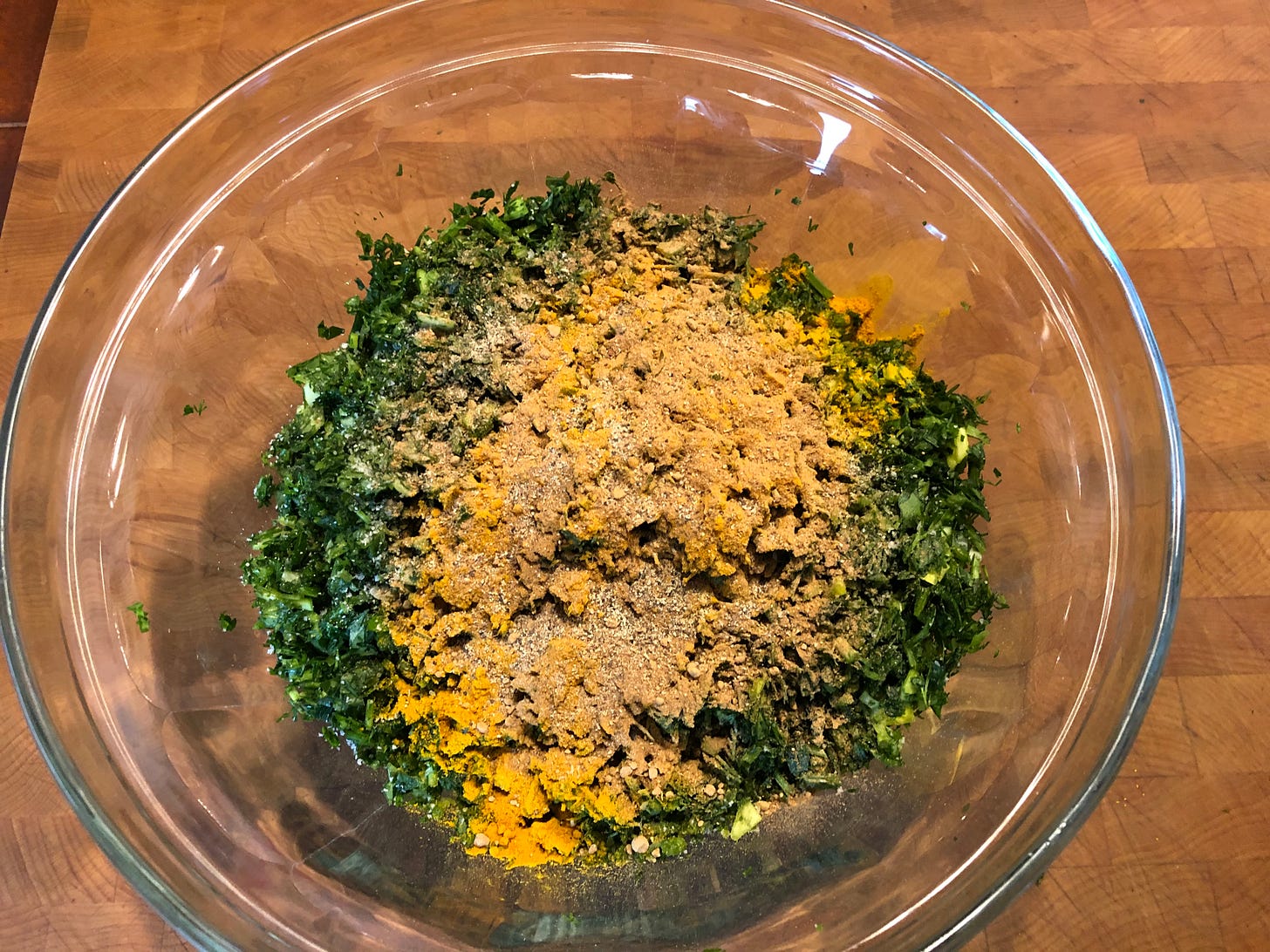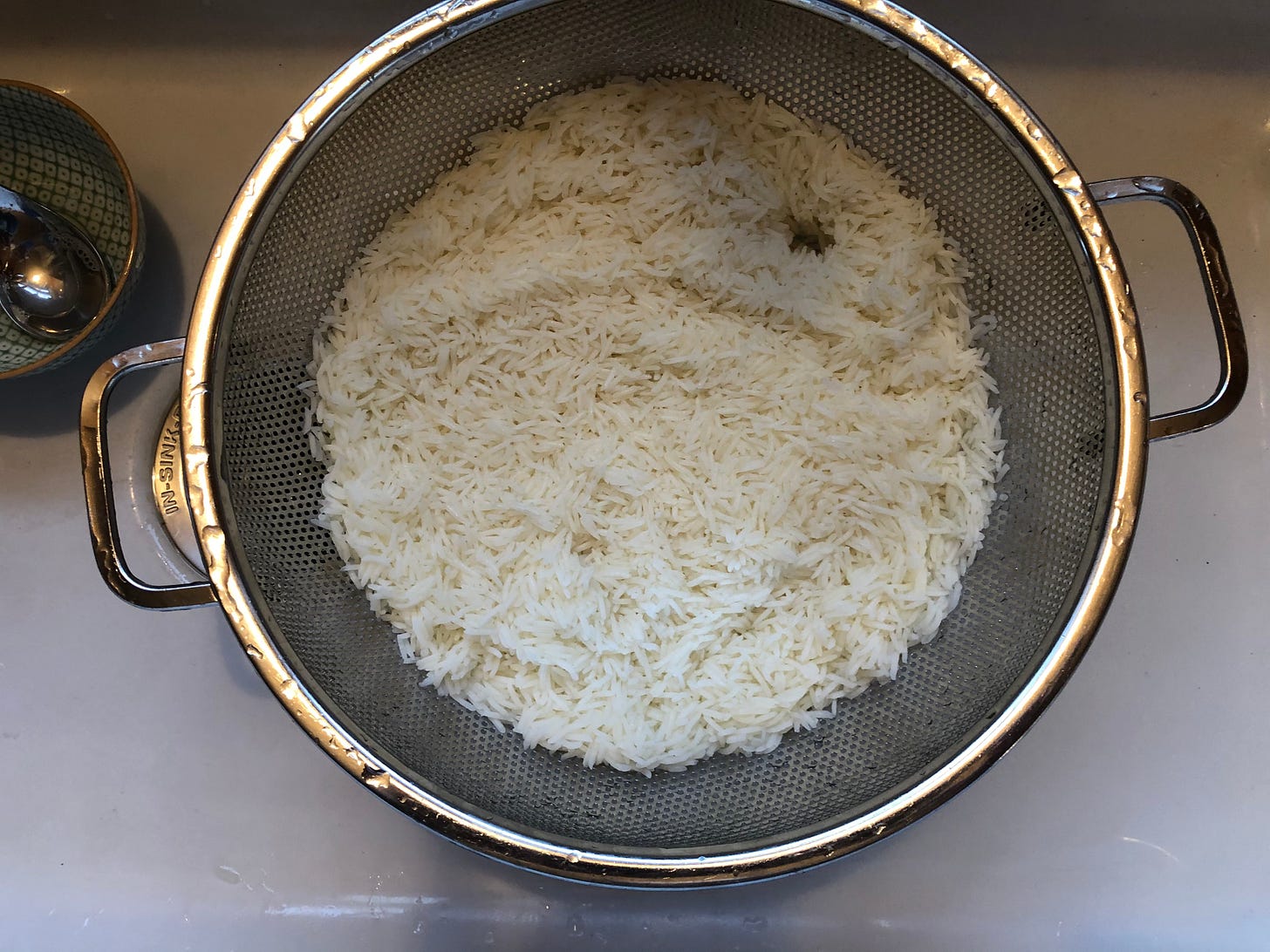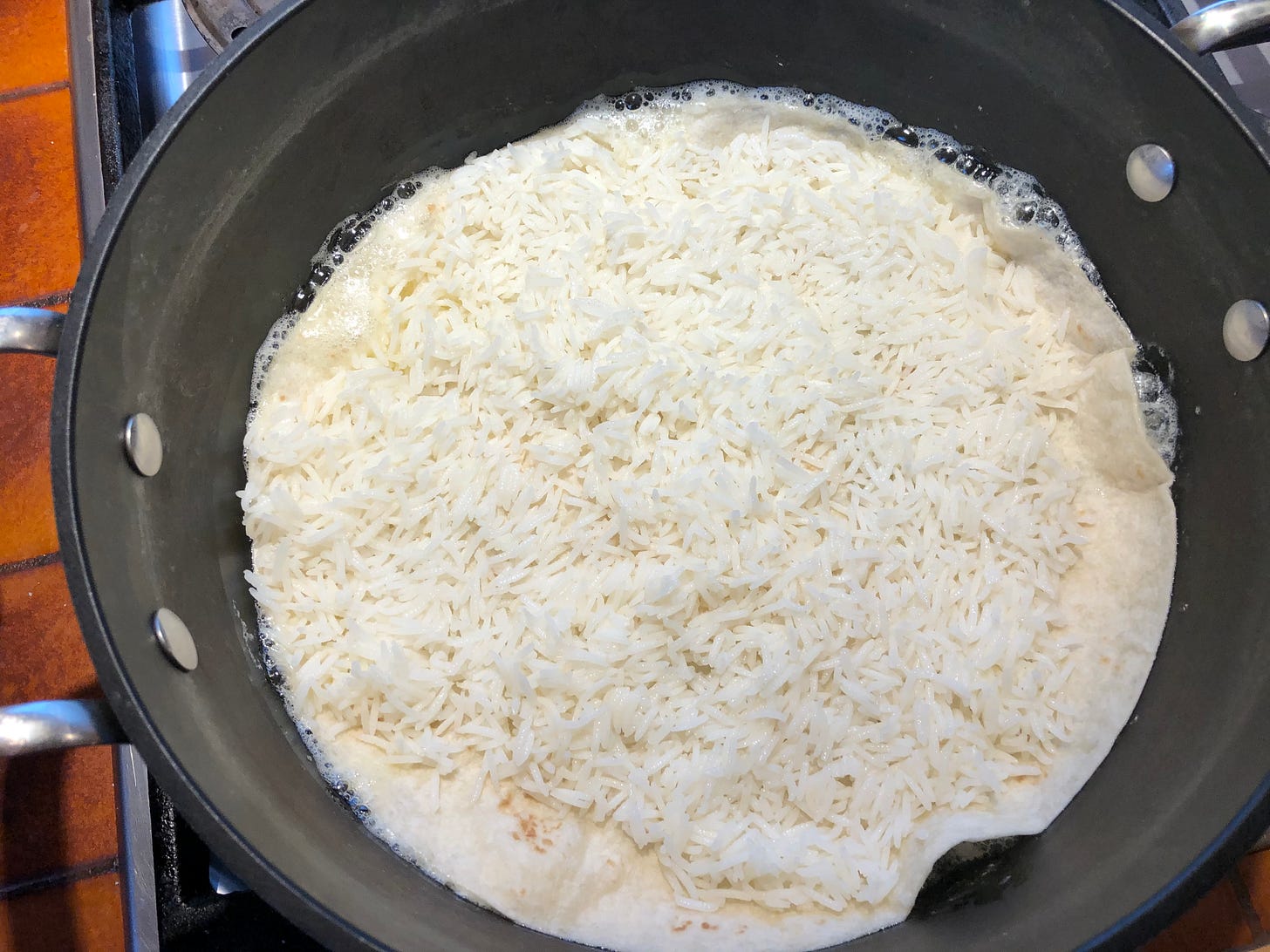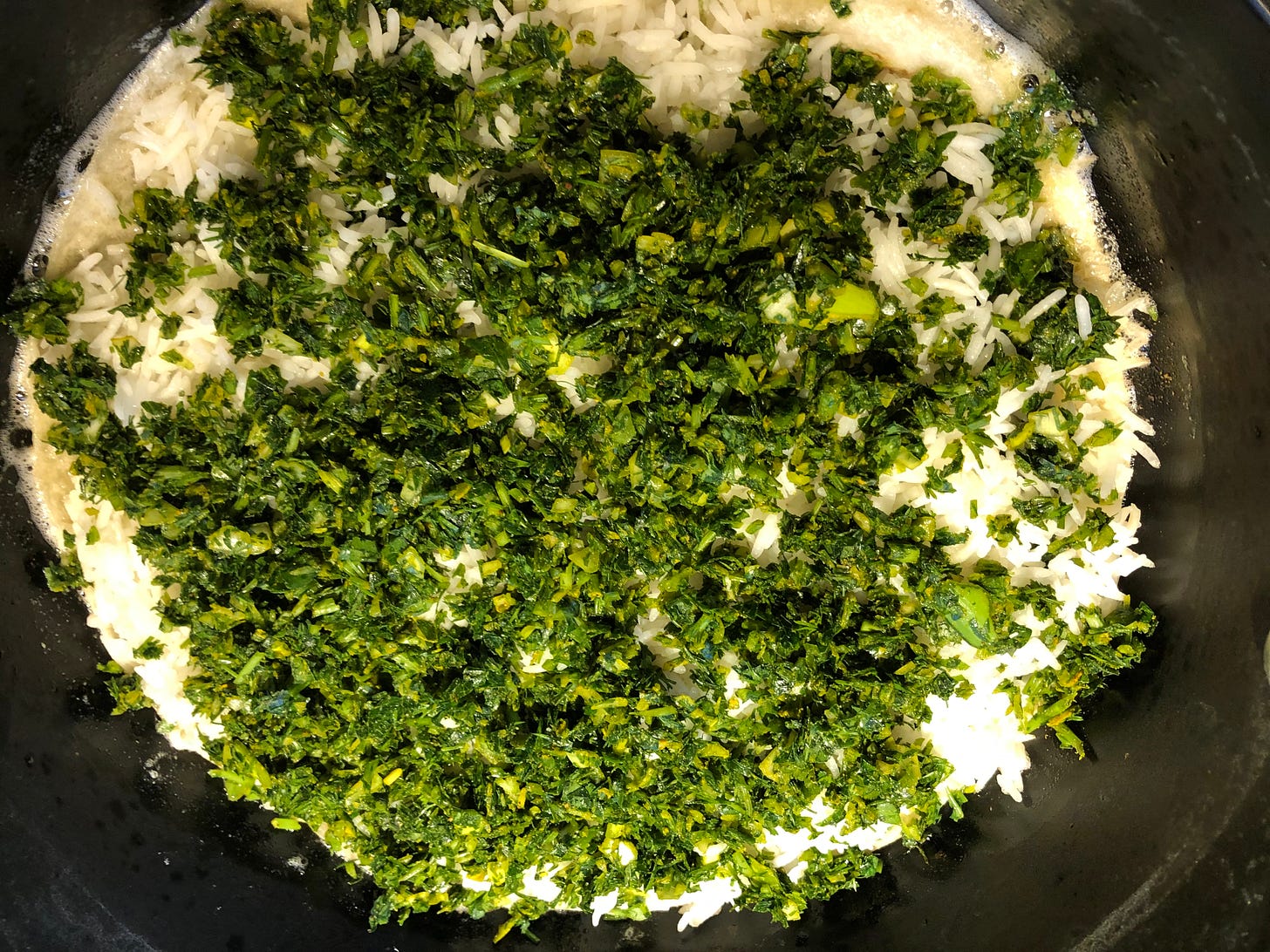Sabzi Polo with Mahi, The New Year Dish, only a month late…
Though Terence O’Donnell never delves into the wonders of Iranian cuisine in “Garden of the Brave in War” Sabzi Polo with Mahi is a dish he most certainly would have eaten many times over the years. It is the New Year dish, the one served on No Ruz, the first day of spring. Sabzi Polo is rice pilaf with herbs. Mahi means fish (always a white fish). Herbed rice with fish.
Polo is another word for rice, and is the second, and more complicated, way of making Iranian rice. As I mentioned in On Making Rice, Iranians use Basmati rice and prefer that grown in India. In Polo, the rice is parboiled, rinsed, and then returned to the pot to steam until done. Most often it is layered with meat and/or vegetables to form what Westerns know as rice pilaf, but an Iranian polo is long, long way from Rice-A-Roni, a dish my mother used to make back in the 1960s.
In Iranian cuisine, a polo is a main feature of the meal. It sometimes contains lamb, sliced into small cubes, as in Lubia Polo, where the lamb is combined with green beans and layered into the rice, or Addas Polo, a lentil rice where the rice and lentils are both parboiled and then layered with caramelized onions, lamb, and dates. To complete the meal, both these dishes are accompanied by braised eggplant or zucchini. Sabzi Polo, however, is one of many that contains no meat in the dish itself. Instead, a small piece of meat, or fish, is served on the side. In other words, the rice is the main course.
One important note before I continue: Iranian cuisine varies throughout the country. For example, Khoresht’e Badamjun, a commonly made eggplant sauce, can be different in the north, south, east, and western parts of the country. It might also vary depending on the province and the city of origin. And most important of all, every family has its own version that has been passed down from mother to daughter over generations. The various dishes, however, are all variations on a theme, be it green beans, eggplant, lentils, or sweet candied orange. (There are quite a few fruity dishes that I love. Perhaps I’ll pass those along, too.) I was taught by my husband’s mother, Bea (not her real name). I spent the first two years I lived in Iran haunting her in the kitchen, a looming shadow perhaps a bit too eager to help. Never mind that I didn’t know the language, at least not at first. With patience and some laughter, Bea taught me Farsi as well as how to cook. Of course, when my husband and I returned to the States, I had to adapt, which wasn’t easy, but if you love a cuisine, you figure out a way. And though Bea passed away, my husband’s sister, who still lives in Iran, often provides helpful hints.
So to Sabzi Polo, the traditional dish served on No Ruz, the Iranian New Year, or the first day of spring, and little more than finely minced herbs and rice, it is actually a fairly easy polo to make.
Sabzi Polo
Serves 4 to 6
· Non-stick 6 ½ quart braising pan with lid
· 2 ½ - 3 cups Basmati rice
· 1 well-trimmed leek (soft parts only)
· 1 bunch fresh dill
· 1 bunch Italian parsley
· 1 teaspoon turmeric
· 1 teaspoon Advieh (We make our own advieh, but this brand, while a bit fancy, is in the ballpark. ½ teaspoon cinnamon could work in a pinch.)
· At least 2 teaspoons of salt and plenty of pepper
· One burrito-size flour tortilla. (This is for the delicacy known as tahdig, or the crispy bottom of the pot. The bread should be lavash, a very thin flatbread, but unless you live in LA or Vancouver, B.C. that’s probably not available.)
· One cube of butter, divided into tablespoon-size slices
· Approximately 2 teaspoons of Iranian Saffron
1. As with Kateh thoroughly wash the rice before beginning. For polo, I also like to allow the rice to soak for a couple of hours. Making polo does need some planning.
2. While waiting for the rice to soak, wash and thoroughly dry the herbs. They should be thoroughly dry, both for easier chopping and for calculating the amount of water needed for the steaming process. (See Step 11) As for the leek, I wash and dry it separately because they tend to hold a lot of dirt.
3. Begin by roughly chopping the leek. Set aside. Then coarsely chop the herbs and combine the two.
4. Now proceed to mince. It takes a while, even with a good sharp knife. Aim for fine.
5. Place the minced herbs in a bowl and add advieh, turmeric, salt, and pepper. Blend, then set aside.
6. Pour the soaking water off the rice and fill the pot anew. The water level should reach about three inches above the level of the rice. You don’t want to crowd the rice kernels as they boil.
7. Add a couple generous handfuls of kosher salt to the water. (Don’t worry, you’ll be pouring this off.) Set the pan on high heat and allow the water to come to a boil, stirring very occasionally, just enough so that stray rice kernels don’t stick to the bottom of the pot. Boil the rice only until the outside of the kernel is soft. Less than al dente. Once the rice reaches this stage, strain it in a large colander, then thoroughly rinse under a stream of cold water to stop the cooking process.
8. Now you need to work fast because that rice can’t sit. Place the pan back on the stove on a medium-high heat. Melt half the butter slices in the pan. Then place the tortilla, or lavash, on top of the butter and fit it into the bottom. Using a slotted spoon, spread a thin layer of rice over the top of the tortilla.
9. Add a layer of the chopped herbs on top of the rice. Then proceed to layer the rice and herb mixture as you would a layer a lasagna. Do so until all the rice and herbs are used. Meantime, watch the heat and try to move quickly. You don’t want that tortilla on the bottom to burn. If you sense it might be, move the pot to another burner set at medium-low.
10. Place the remaining butter slices on top of the rice and sprinkle with saffron. You can grind the saffron in a mortar and pestle and combine it with a tablespoon of water, but somehow, I always forget and this method also works.
11. Add a few tablespoons of water, enough to create steam, a quarter of a cup at most, and place the pot’s cloth covered lid on top. (See Kateh) If you haven’t already, lower the heat. I like moving the pot to a different burner set on medium-low for about 10 minutes, just enough for steam to build. Now turn the temperature down to a slow burn and allow to steam for approximately 45 minutes.
12. This is a good time to think about preparing the fish. I like to use halibut, which comes into season in the spring, and it tastes delicious as an accompaniment. I bread and fry it, which is how it’s served in Iran, but if you are making the rice as an accompaniment and planning on eating the fish as the main course, I refer you to my friend Karen Silve, who has a delicious method of cooking Crispy Fish.
13. But the rice is not done! There two more important steps. First, is placing it on a platter. Begin by gently removing the top layer of saffron rice and place it aside on a plate. Now, ever so gently–you want to damage as few of the delicate rice kernels as possible–spoon the rice onto your serving platter, gently, gently, combining the herb and rice layers as you go. Once you have a nice spread of rice, again gently, sprinkle the saffron rice over the top.
(I thought that I had a photo of the full platter of Sabzi Polo, but I must have inadvertently deleted it. So sorry. I’m sure yours will look grand.)
14. The last and final step is to remove the tahdig (remember that tortilla?) from the bottom of the pot. It may take some maneuvering, but you should be able to slide a wooden spoon underneath its edge so that you can lift the tortilla. You don’t have to be gentle now. The tortilla should be so crisp and buttery that it’s stiff. Holding it with a paper towel (it’s hot!), try to knock as much rice from the crisp tortilla as you can. This is the tahdig. Break it into edible portions (it’s finger food) and serve it along with the fish and rice.
Yes, those are pickles (brined, not vinegar). Iranians eat their rice with a wonderful array of condiments. I encourage you to try this. The dark crispy bread to the right of the polo is a piece of tahdig, and my halibut, breaded and fried, is to the back.
You may also notice that I changed the wine pairing. An Amarone, while it reflects the sweet and exotic nature of Iran, is not a good wine to accompany either Sabzi Polo or a fine spring day. And I do like to eat Sabzi Polo with Mahi throughout the spring and summer. It’s a very delicious warm weather dish. Bon Appetit!





